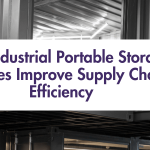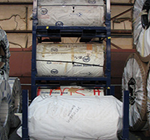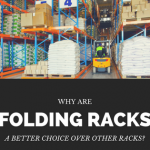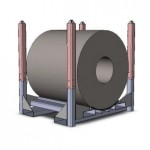A Comprehensive Guide on Pallet Rack Flue Spaces
Warehouse safety and risk prevention are of paramount importance since different operations carried out in such setups involve a high level of risk. The threat of fire is one serious concern in any warehouse, and finding the right solutions for safeguarding and people and property is necessary. There are several ways to reduce the chance of a fire overtaking, and maintaining pallet rack flue space is widely implemented. Flue spaces are nothing but a clear representation of horizontal and vertical lines along with the racking system between the rack rows, and they also imply the direction of loading. A well-designed pallet racking system must have flue space between pallet loads and upright frames. By keeping the flue space cleared of loads within the pallet rack structure not only safeguards warehouse inventory but serves as a safety measure against fire damage. Are you interested to know more about them? If that sounds yes, then read this post till the end.
Introduction and Importance of Pallet Rack Row Flue Spaces Explained
According to the National Fire Protection Association or NFPA, the flue space is a clear vertical opening within the pallet rack structure. These openings allow vertical lines of sight stemming from the floor up to the ceiling. These spaces act as fire code requirements because they reduce the pallet racks’ damage from fire by allowing fire, heat, and smoke to ventilate upward & quickly activate the sprinkler systems. This warehouse racking structure also allows the water to penetrate down through the multiple layers of stored products. Therefore, it is important to keep flue spaces clear of inventory blockage within the pallet rack structure. This may allow for instant fire suppression and fire detection.
Types of Flue Spaces in Pallet Rack Systems
According to the NFPA flue space requirements standard, two types of flue spaces are considered while designing pallet racks for your warehouse.
- Transverse Flue Space: This is the gap or opening space between the products that are stored parallel to the direction of loading. If the products are stacked less than 6″ from other pallets, then they may be blocking the transverse flue space of pallet racks. Flue keepers are used to prevent the pallets from encroaching into the flue space and improve the working of sprinkler systems. These are designed as per NFPA standards and can be installed in non-standard storage units.
- Longitudinal Flue Space: This is spacing between back-to-back rows of pallets racks. Basically, products loaded far behind on the rack in both rows may result in the blockage of the flue. This can be avoided by applying proper warehouse rack space and flue protection standards.
Flue Space Dimensions and Guidelines
Recommended Flue Space Dimensions
Flue spaces are the gaps left between rows of pallet racks to allow for ventilation, access by firefighting personnel, and the dissipation of heat in case of a fire. The dimensions of these spaces are crucial for maintaining safety and operational efficiency in warehouse environments:
Typical Width: The recommended width of a flue space between pallet racks is generally around 12 to 18 inches (30 to 45 cm). This provides enough room for ventilation and easy passage for forklifts or firefighting equipment.
Height: Flue spaces should extend from the floor level to a height of at least 18 inches (45 cm) above the top of the highest load. This ensures proper air circulation and accessibility.
Factors Influencing Flue Space Requirements
Several factors determine the specific rack flue space dimensions needed for a given pallet rack system:
Rack Type: Different types of pallet rack configurations (single deep, double deep, drive-in, etc.) have varying requirements for flue space dimensions due to their designs and storage capacities.
Fire Safety Regulations: Local fire codes and regulations might dictate specific flue space dimensions based on the type of goods stored, the rack layout, and the presence of fire suppression systems like sprinklers.
Sprinkler Systems: The presence and location of sprinkler systems can affect flue space requirements. Adequate space must be provided to ensure that the sprinklers can effectively reach any potential fire.
Aisle Width: The width of the aisles between rack rows can impact rack flue space dimensions. Wider aisles may allow for slightly narrower flue spaces, but the overall ventilation and accessibility must still be maintained.
Consequences of Inadequate Flue Spaces
Neglecting proper flue space dimensions can lead to various detrimental outcomes:
Fire Hazard: Inadequate flue spaces hinder heat dissipation and ventilation during a fire. This can cause fires to spread more rapidly and make firefighting efforts less effective.
Limited Accessibility: Insufficient flue spaces can obstruct the movement of forklifts and other equipment, making it challenging to retrieve or store goods efficiently.
Reduced Safety: Emergency responders may face difficulties accessing the source of a fire or maneuvering within the warehouse if flue spaces are too narrow.
Compromised Sprinkler Effectiveness: If sprinkler systems cannot adequately reach the fire due to blocked flue spaces, fire suppression efforts will be less successful.
Structural Strain: Stacking items too close to the racks or within the flue spaces can put excessive pressure on the racks and compromise their structural integrity.
How to Keep Flue Spaces Clear?
There are many factors that can affect the flue space’s effectiveness in preventing fire spread. With a well-designed pallet racking system and properly sized products, some appropriate safety solutions help in keeping your flue space clear and visible.
- Rack Straps: This is one of the common ways to keep your flue space clear. These straps are attached to the backside of each bay, stopping the pallets from being pushed back into flue space.
- Wire Rack Backing: As the name implies, they are installed on the rear side of the rack. Primarily, they help prevent products from falling off the racking system but can also be used to restrain products from blocking the flue space.
- Pallet Stop Beams: They are bolted into the pallet rack upright from 6” to 12” beam level. This helps stop the products from being pushed back into the flue space.
By now, you may have understood that maintaining the pallet rack flue space is vital for the safety of the warehouse inventory and staff. Still, if you have any concerns about flue spaces on pallet racks, you can approach an expert for a solution, SPS Ideal Solutions is one of the leading suppliers of racking systems as well as shipping and material handling solutions.
Related Posts:
- How to Avoid Pallet Racking Mistakes?
- An Essential Guide: Things to Consider Before Buying Pallet Racks
- Used vs New Pallet Racking System – Which One to Choose?
- How to Find the Right Size of Pallet Rack?
About The Author










